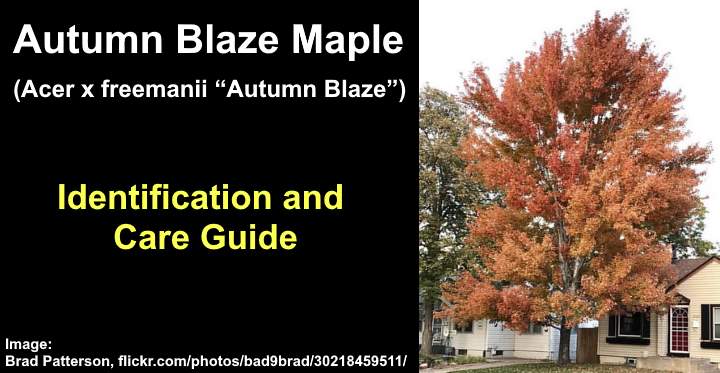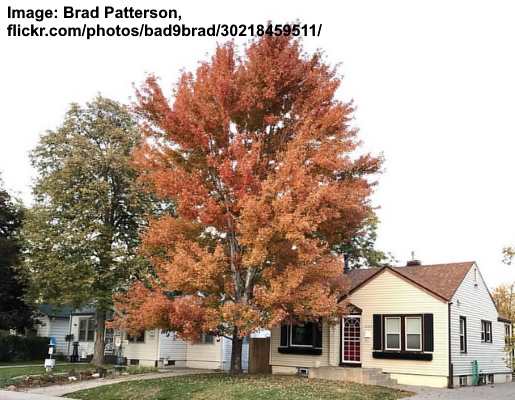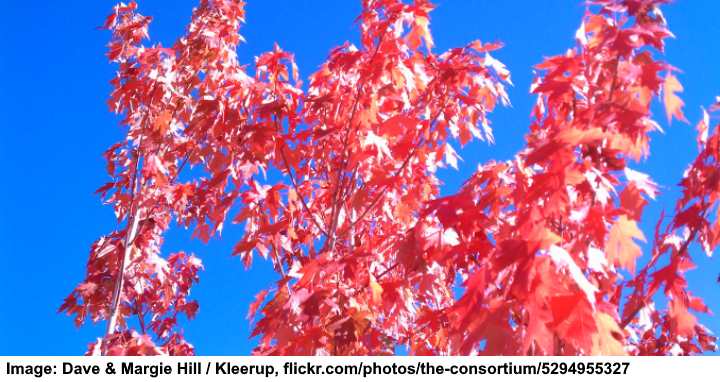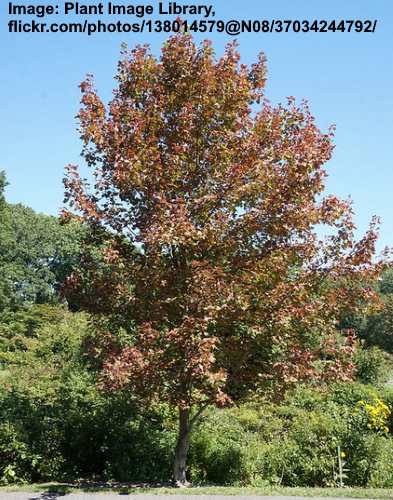‘Autumn Blaze’ Maple (Acer x freemanii ‘Autumn Blaze’): Leaves, Bark – Identification

The ‘Autumn Blaze’ maple tree is a beautiful ornamental tree, prized for its spectacular orange and crimson red fall color. The ‘Autumn Blaze’ maple is a deciduous tree with an attractive upward branching habit, rounded canopy, and deeply lobed maple leaves. There is no mistaking the ‘Autumn Blaze’ maple tree in a fall landscape as it retains its scarlet red foliage for several weeks before dropping.
Also called Freeman’s maple, the hybrid maple tree is classed as one of the most outstanding deciduous trees for its autumn colors.
This article is a comprehensive guide to the identifying features of the maple ‘Autumn Blaze.’ In addition to pictures and descriptions of the maple tree, you’ll find helpful tips on planting and caring for this tree in your garden landscape.
‘Autumn Blaze’ Maple Facts

‘Autumn Blaze’ maple tree
The ‘Autumn Blaze’ maple (Acer x freemanii ‘Autumn Blaze’) is a hybrid ornamental tree that is a cross between the silver maple (Acer saccharinum) and the red maple (Acer rubrum).
‘Autumn Blaze’ maple grows between 50 and 60 ft. (15 – 18 m) tall and 40 ft. (12 m) wide.
‘Autumn Blaze’ maple trees are fast-growing trees that grow 3 to 5 ft. (1 – 1.5 m) per year under ideal conditions. The attractive Freeman maple trees perform best in full sun to partial shade and are adaptable to various soil types. Its best leaf color is when it gets some shade.
Growing an ‘Autumn Blaze’ is possible in USDA zones 3 through 8. The hardy tree can thrive in freezing temperatures and tolerate warm summers. In addition, because it is relatively drought-tolerant, the maple requires little maintenance, even during relatively dry periods.
‘Autumn Blaze’ maple has a shallow root system that won’t interfere with sewer lines, however the roots tend to rise to the surface with age. As a result, the maple roots can cause problems in lawns, sidewalks, or buildings. And it means that the tree is susceptible to damage in high winds.
Other cultivars of the hybrid Acer x freemanii also produce stunning fall colors like the ‘Autumn Blaze.’ For example, there are maples with bright scarlet or crimson red leaves like the seedless ‘Marmo,’ ‘Scarlet Sentinel,’ ‘Firefall,’ and ‘Indian Summer.’
Related reading: Learn more about Japanese maple trees.
‘Autumn Blaze’ Maple Tree Leaves

‘Autumn Blaze’ maple leaves
Leaves on the ‘Autumn Blaze’ tree have the classic maple leaf shape. The maple leaves have deeply cut five lobes, with the central lobe wider toward the tip. The leaves are dark green with a glossy shine in spring and summer. In the fall, ‘Autumn Blaze’ foliage turns vibrant orange-red.
‘Autumn Blaze’ maple tree leaves measure 3” to 6” (7.5 – 15 cm) long and wide. The maple leaves are identified by their jagged-looking lobes that almost reach to the leaf’s midrib. The simple leaves grow in an opposite arrangement on the tree and appear in early spring.
‘Autumn Blaze’ Maple Fall Color

‘Autumn Blaze’ maple leaves are orange-red to brilliant red in the fall
Orange-red is the best color to describe the fall color of ‘Autumn Blaze’ leaves. The maple leaves emerge with a reddish tint, turn glossy green, then transform into an orangey-red to brilliant red during the fall. This impressive red color makes these maple trees easy to identify in an autumn landscape. The red colors are most vibrant when grown in partial shade.
‘Autumn Blaze’ Maple Tree Bark
The bark on the ‘Autumn Blaze’ maple tree is light silvery-gray that is relatively smooth. The bark becomes slightly furrowed as the maple tree matures but retains its gray color. The attractive gray bark and the tree’s silhouette give the maple visual appeal when the branches are bare in winter.
‘Autumn Blaze’ twigs are brown-red, and red buds appear in winter, adding to the tree’s appeal as a beautiful landscaping tree with an all-year-round appeal.
‘Autumn Blaze’ Maple Tree Flowers
‘Autumn Blaze’ is a flowering maple tree; however, the flowers are generally not seen. Because it’s a hybrid maple, it rarely flowers. However, if the tree blooms, it may produce yellowish-green or red clusters of drooping flowers.
After blooming, an ‘Autumn Blaze’ maple may produce fruit in the form of winged seeds called samaras. However, it’s rare to find an ‘Autumn Blaze’ maple that produces flowers and seeds.
‘Autumn Blaze’ Maple (Acer x freemanii ‘‘Autumn Blaze’’) Identification

Acer x freemanii ‘Autumn Blaze’
You can identify an ‘Autumn Blaze’ maple by its distinctively lobed leaves that create a star shape. The leaves have five deep lobes with toothed margins, characteristic of other maple leaves. The maple has an upwardly spreading branching habit, silver-gray bark, and foliage that turns bright red in the fall.
When to Plant ‘Autumn Blaze’ Maple Tree
Plant the ‘Autumn Blaze’ maple in late fall or spring for best results. However, fall planting tends to give the decorative trees a better chance as the soil is still warm. Ensuring you plant the maple tree in the ground well before frost gives the root system enough time to get established.
Where to Plant ‘Autumn Blaze’ Maple Tree
The best location for planting an ‘Autumn Blaze’ maple tree is in full sun. In warm climates, the location should have some afternoon shade. The maple tree will grow best when planted in well-drained, fertile soil. ‘Autumn Blaze’ maples adapt well to most soil types and grow in sandy, loamy, or clay soil.
Spacing is another consideration when deciding where to plant the maple tree. If you are planting the ‘Autumn Blaze’ maple as a specimen tree, leave about 40 or 50 ft. (12 – 15 m) between the trunk and buildings or other trees. Appropriate spacing is also necessary to protect the maple’s shallow root system.
‘Autumn Blaze’ maples need enough space from other trees to allow the roots to grow strong and deep.
It’s also good to remember that the maple creates a spreading, rounded canopy that can shade shrubs and plants in its understory. Therefore, also think about the size of the mature tree. You may want to grow plants for ground cover in full shade under the tree’s canopy.
How to Plant ‘Autumn Blaze’ Maple Tree
Plant a maple tree ‘Autumn Blaze’ by digging a hole twice as wide as the root ball and about 4” (10 cm) deeper. Ensure that the tree is growing the same height as in the nursery pot. Next, backfill the hole using native soil, pressing down as you go.
After planting the maple tree and ensuring it is stable, thoroughly saturate the root area. This will help remove remaining air pockets and give the roots a good start. Lastly, put a thick layer of mulch around the root area, ensuring that 2” (5 cm) around the trunk is free.
Keep the soil moist after planting a maple tree by watering it every two weeks. During the first growing season, you must ensure that the ground is consistently moist. This requires watering it regularly to help the roots grow well.
Digging a larger hole gives the roots more room to spread out and develop a robust root system. Planting the tree in the fall helps the root system to grow well throughout the winter, ready for vigorous growth the following spring.
How to Grow ‘Autumn Blaze’ Maple Tree From Cuttings
To grow an ‘Autumn Blaze’ maple from cuttings, cut 4” to 6” (10 – 15 cm) lengths of stem tips from the tree in summer or early fall. Next, remove the lower leaves from the stem cuttings and use a sharp knife to strip 1” (2.5 cm) of bark from the cut end.
After preparing the cutting, dip the end in rooting hormone and set the cutting in a potting mix consisting of moist peat moss and perlite. The cutting will root best when it’s around 2” (5 cm) deep. To give your plant some extra warmth and moisture, cover the pot with a plastic bag.
Lastly, place in a warm location, away from direct sunlight.
It should take between four and eight weeks for the roots to grow. After roots are established, remove the plastic cover. It’s a good idea to transfer the cutting to a larger pot containing fertile potting soil.
Then start to acclimatize the plant by placing it outdoors during the day and back inside at night. Do this for ten days, after which you can transfer the rooted cutting to the ground in late fall.
‘Autumn Blaze’ Maple Tree Care Guide
‘Autumn Blaze’ is a hybrid of the silver maple and red maple that offers the best qualities of both parents. This makes the maple relatively robust and easy to care for. After it’s established in the landscape, it only needs moist soil and full sun to grow well and be pest-resistant.
Please read on to find out how to care for a maple tree, keep it healthy, and prune it to encourage vigorous growth.
How to Water ‘Autumn Blaze’ Maple Tree
Water an established maple tree ‘Autumn Blaze’ only during dry periods. Typically, the maple tree is drought-tolerant and regular rainfall should provide sufficient hydration for the roots. You should also avoid overwatering the tree because “wet feet” can lead to root rot and other growth issues.
Watering an ‘Autumn Blaze’ maple is crucial when the tree is young. You will need to water the tree three times a week for several weeks, making sure the water soaks evenly throughout the root zone. Typically, the maple tree requires 1” (2.5 cm) of water a week.
Signs you need to provide more water for a maple tree in your garden landscape are leaves that turn brown during summer or premature leaf drop before they turn bright red.
‘Autumn Blaze’ Maple Tree Fertilization
An ‘Autumn Blaze’ maple tree benefits from annual spring fertilization. Use a high-nitrogen tree fertilizer for leafy trees. For example, a natural or organic tree fertilizer with an NPK rating of 12-4-8 or 16-4-8 can help maintain the tree’s health and promote plenty of leaves.
However, most maple trees grow well without additional fertilization. Usually, before applying fertilizer, take a soil sample to check for nutrient deficiencies. That way, you avoid over-fertilizing the tree and burning the roots.
Top tip for growing ‘Autumn Blaze’ maples: A newly-planted maple tree doesn’t require fertilization during its first year. You should also avoid amending the soil with fertilizer when planting the nursery tree.
Pruning ‘Autumn Blaze’ Maple Tree
‘Autumn Blaze’ trees require regular pruning to keep their shape and encourage healthy growth. Typically, pruning every three to five years helps keep the tree’s structure sound. You can also prune dead and diseased branches twice a year to promote growth and increase air circulation.
Typically, a young ‘Autumn Blaze’ maple tree doesn’t require pruning for the first few years. The tree usually develops a good shape without maintenance. After two or three years, you can prune the maple tree annually.
The best time to prune ‘Autumn Blaze’ maples is late winter or early spring. For regular annual pruning, look for branches showing signs of decay or disease. Also, remove branches that are crisscrossing or rubbing against other limbs. You’ll also need to remove any suckers growing from the base of the tree.
For mature trees with load-bearing limbs, it’s best to call a professional arborist every few years. They can assess which of the larger branches need removing to improve the tree’s shape and structure.
Pests Affecting ‘Autumn Blaze’ Maple Tree Growth
‘Autumn Blaze’ maple trees are typically robust, pest-resistant trees that are rarely affected by pests. However, you may find that common garden bugs like woolly aphids, scale insects, and tree borers can affect the tree’s health.
Woolly alder aphid (Paraprociphilus tessellatus) is a tiny black bug with a white fuzzy coating. The signs of these bugs are white, fuzzy pests on twigs, leaves, and bark. Infested leaves may wither and fall early. You may notice honeydew on the tree and increased ant activity around the tree. However, woolly aphids rarely do lasting damage to an ‘Autumn Blaze’ maple.
Related reading: How to kill aphids on outdoor plants.
Scale insects can affect maple trees, including the ‘Autumn Blaze’ cultivar. Scale bugs are challenging to spot because they appear as bumpy brownish-black growths on maple limbs. Some seem like a woody bump, whereas others have a cottony growth around them. The effects of scale can be premature leaf drop and stunted growth.
Related reading: How to get rid of scale insects.
Ambrosia beetles (Xylosandrus crassiusculus) are small wood-boring beetles that bury into maple tree trunks and branches. Typically, the pesky beetles affect younger trees with thinner bark. The most common sign of these beetles is toothpick strands poking out from the tree. Getting rid of these tree-destroying beetles usually requires professional help.
Diseases Affecting ‘Autumn Blaze’ Maple Tree Growth
‘Autumn Blaze’ maple trees are relatively disease-resistant if they get plenty of sunlight, appropriate watering, and if you avoid overfertilizing them. However, various foliar diseases like leaf scorch, anthracnose, and leaf spot can affect maple leaves.
Leaf scorch is common during dry weather, high temperatures, and strong winds. The maple leaves may turn yellow because they don’t get enough water. However, contaminated soil can also cause leaves to appear scorched. To prevent or resolve leaf scorch, water the maple tree with 1” (2.5 cm) of water every week during arid weather.
Anthracnose (Aureobasidium apocryptum) is a fungal foliar disease that causes leaves to turn brown and branches to become deformed and crooked. This maple leaf disease is more prevalent during damp, cool weather. The best way to resolve anthracnose on maples without chemicals is to remove and destroy infected leaves and limbs.
Leaf spot can be caused by various fungal or bacterial diseases. The best way to prevent these diseases from spreading is to rake up fallen leaves in the fall and remove infected foliage and branches from the tree.
Related articles:
